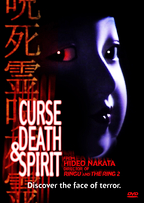
Combining our modern terror of technology with traditional supernatural folklore in the sensational thriller Ringu, Hideo Nakata returned faith to the frightful few hungry for dark miracles in an age overburdened with slasher pastiches and retarded remakes. With careful attention to detail, a psychologist's knowledge of character, and an expressionistic eye for atmosphere, Nakata returned married a subversively complex storytelling style to surreal images whose primal weirdness spoke to something deep inside both our archetypal cultural and personal memories. In Curse, Death and Spirit, a mini-anthology of three supernatural stories united by spiritual themes and a satisfyingly subdued sense of visual terror, Nakata weaves disturbing surrealistic images amidst carefully constructed narratives, frightening and enlightening simultaneously.
A dark descent into culpability, the power of transformation, and nightmares of the supernatural world and cathartic self, these stories pick the raw wounds of our collective psyche. A careful script and Nakata's stealthy direction interweave universal symbols of occult awe with the personal anxieties of convincingly crafted characters, both of which conspire to touch the audience where it hurts worst - in the very intimacy of its homes, hearts, and secret desires. Dissecting expectations with carefully placed shocks, Nakata explores a wealth of philosophically rich ideas in stories as visually suspenseful as they are beautifully captured by stunning photography - moving photos whose candy-house lighting evoke the spirit and colorful hues of the Other World with which these adult Faerie tales of death and desire deal.
While occasionally disjointed, restrictions of time and budget preventing the young director from exploring ideas and character to completion, this sophomoric effort by the director is both historical document and pleasurable descent into ghostly terrors crafted with enthusiasm and atmospheric tenacity. Dealing with several of the themes which Nakata would develop with greater passion and proficiency in such feature films as Ghost Actress and Dark Water, this admittedly low budget, psuedo-amateurish digital collection of isolation, outrage, and corrupt pasts haunting uncertain futures affords us a view of its director's origins and evolving skills; at the same time, it is a satisfyingly creepy homage to the traditional anthology films of macabre cinema.
The stories themselves occupy that rare shadow-land between art and believability, evoking the polished terror of literary nightmare while emitting the rustic, earthy flavor and authenticity of the folktale - not surprising considering their dept to oral folk belief. Shot around a decade or more ago, these tributes to terror run approximately twenty minutes each. While such brevity makes it impossible to instil serious character development or exposition, and thus the emotional involvement required for truly satisfying terror, these vignettes do capture the beautifully dark wonder of the supernatural in feeling if not in mechanics. These shorts work much the same way dreams do, appealing to our primal sense of the absurd, touching off primal instincts and reactions in our animal minds, and as such, are successful pieces of dark art. Short cold kisses in the dark, each tale is linked by the narration of a ghostly event by its survivor, a well-worn albeit effective trope that allows for continuity and further develops the urban legend resonance.
"The Cursed Doll" is the simplistic yet menacing nightmare of a teenager menaced by a demonic doll capably told, summoning more than a few chilling moments of atmosphere and creeping dread (despite silly effects). "The Spirit of the Dead" focuses on a recently widowed wife and her sister who takes her son and two cousins on a camping trip and find more than they expected. This story of a fragmented modern family striving to reconnect themselves with the world (and themselves) after familial loss quickly descends into supernatural terror as the son discovers that the tormented spirit of a mother has mistaken him for her child. While not as creepily shot or commendably acted as the first episode, and despite a lackluster plot that offers little surprise, a resonance of loss and bitter-sweet irony lends substance to an otherwise routine haunting. Perhaps the most substantial entry, "The Haunted Inn" features three adolescent girls on a trip to a rustic, traditional Japanese inn, discovering too late that by doing so they have become embroiled in a cyclical occult tragedy. While this segment also suffers from lack of time or budget, not allowing the story room to grow and breathe, the amounts of dread that are established are impressive precisely because of their minimalism.
The presentation of this made-for-television ode to the outré is respectable and clean, but incapable of disguising its television roots. Despite stylistic flaws, this shot-on-video production exhibits a nicely colored frame, with hues and background distinct. Mercifully there isn't the washed out picture of typical television releases. Likewise, no grain is noticeable, and the soundtrack is clear and concise. Special features include a photo gallery and trailers for other AsiaVision releases.
Suffering from impossibly short running times, scant budgetary resources, and a director just developing his thematic and visual style, Curse, Death and Spirit is frustrating in its taunt of what could have been - and would be in Nakata's later films. Unable to fulfil its promise as an organically fresh or completely satisfying exploration of surface scares or emotionally penetrating subtext, the individual stories at times more closely resemble scenes in some unmade feature film than pieces of a larger story-canvas. Despite this, the aforementioned moments of atmosphere, creepy incidents, and above-par acting lend this fear-fest enough depth and artistry to succeed as modern incarnations of traditional folklore. In fact, that is precisely what these dark delicacies remind me of - short yet effective fables of average people caught up in supernatural tragedies, structured and told with the rich simplicity of a traditional legend.
Review by William P Simmons
| Released by AsiaVision |
| Region 1 NTSC |
| Not Rated |
| Extras : see main review |